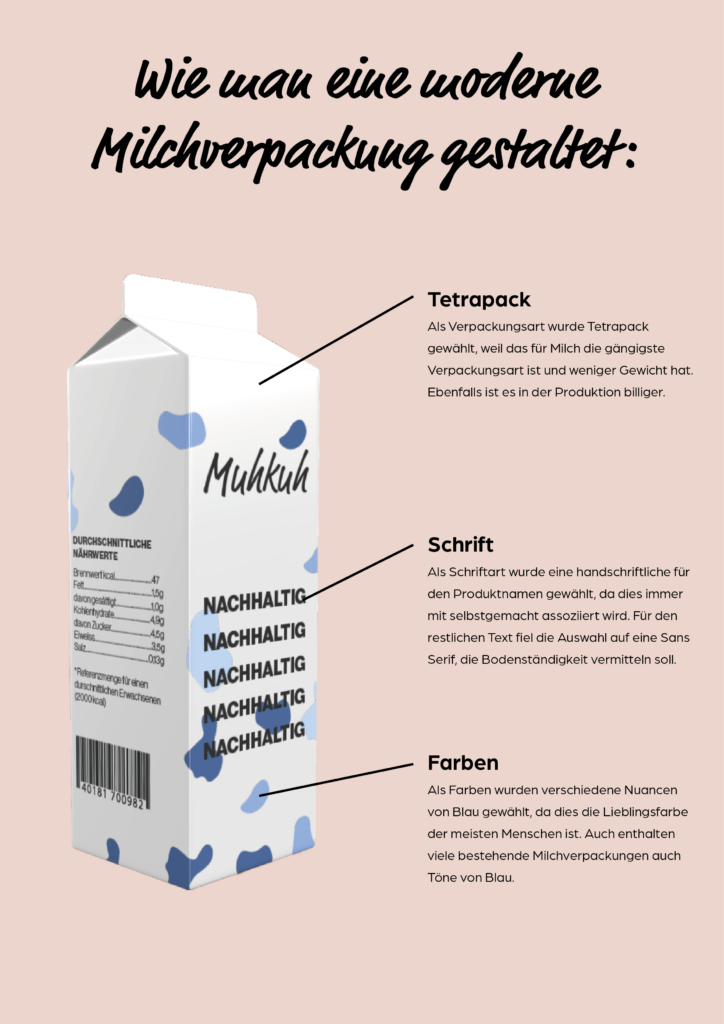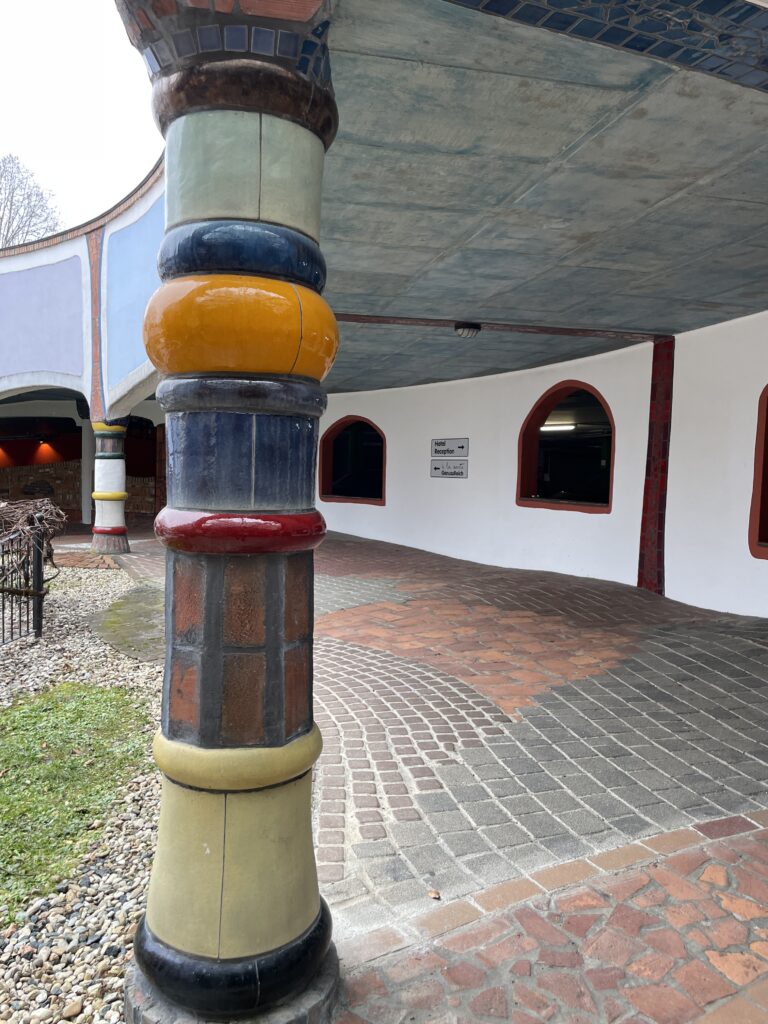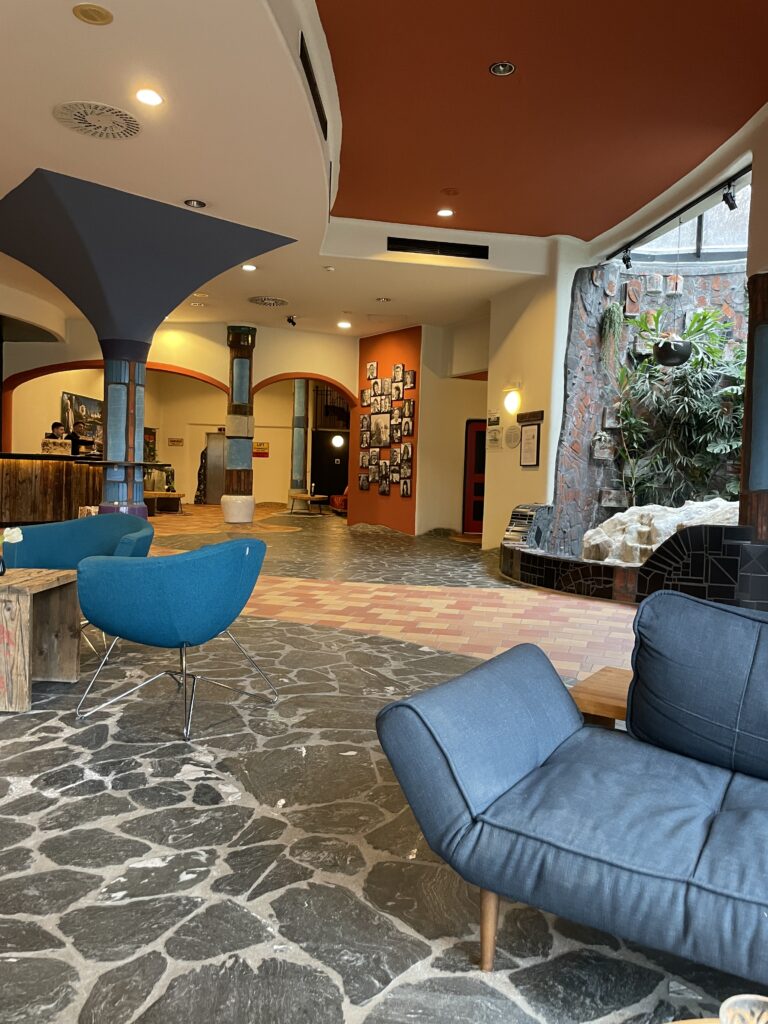
In der Lehrveranstaltung “Creation & Conception” habe ich eine Infografik im Andenken an meine Masterarbeit erstellt. Ich habe eine Milchverpackung gestaltet und erkläre in der Infografik, warum ich mich für dieses Design entschieden habe.

In der Lehrveranstaltung “Creation & Conception” habe ich eine Infografik im Andenken an meine Masterarbeit erstellt. Ich habe eine Milchverpackung gestaltet und erkläre in der Infografik, warum ich mich für dieses Design entschieden habe.
Therme Blumau
In der Therme Blumau fielen mir sofort all die Formen und Farben auf. Es sieht aus, als wäre das gesamte Gebäude per Hand angefertigt und frei gestaltet. Dies hat mich an mein Thema analoge Kreativität erinnert. Friedensreich Hundertwasser versuchte sich den Formen der Natur anzunähern und wurde von ihr und all den analogen Formen inspiriert. In seinen Gestaltungen findet man wohl sehr schwer gerade Linien wieder. Es wirkt handgemacht und spiegelt für mich die Liebe des analogen Schaffens wider. Beim analogen Gestalten und »Freihand« arbeiten sind perfekt gerade Linien auch nur selten. Es geht mehr, um das perfekte im Unperfekten zu sehen und weniger Augenmerk auf winzige Details zu legen. Analoges Design kann spontan sein und es eröffnen sich neue kreative Wege im Zuge des Gestaltungsprozesses.



Der junge Friedrich Stowasser, später als Friedensreich Hundertwasser bekannt, zeigte früh künstlerisches Talent, was in seinem Schulzeugnis durch einen “außergewöhnlichen Farben- und Formsinn” betont wurde.
Hundertwasser selbst verabscheute die nüchterne, geradlinige Nachkriegsarchitektur und fand Inspiration in der geschwungenen, farbenfrohen Architektur von Antoni Gaudί und dem französischen Autodidakten Facteur Cheval. Der Künstler war der Überzeugung, dass gerade Linien, rechte Winkel und sterile Regelmäßigkeiten dem Wesen des Menschen nicht entsprechen und ihn krank machen. Nach Hundertwassers Auffassung sind Gebäude die dritte Haut des Menschen, nach der Epidermis und der Kleidung. Daher sollte der Mensch nach seiner Vorstellung die Gestaltung seiner Wohnung individuell beeinflussen können.
Er ließ sich nicht nur von der Natur inspirieren, sondern fand seine gesamte Lebensphilosophie im Einklang mit der Natur statt. Sein lebenslanges Engagement galt Umweltfragen, Naturschutz und einer humanen Architektur.
Quellen:
Ich habe mir ein Video zum Thema Kreativität angesehen – das Video »Creativity: The science behind the madness« von Big Think enthält Beiträge von verschiedenen Sprecher:innen, darunter Rainn Wilson, Anthony Brandt, David Eagleman, Scott Barry Kaufman, Wendy Suzuki, Ethan Hawke, Beau Lotto und Beau Lotto. Jeder von ihnen hat seine eigenen Ideen und Vorstellungen zum Begriff Kreativität.
Kreativität ist für jeden zugänglich:
Die Sprecher:innen betonen, dass Kreativität für alle Menschen möglich ist, unabhängig von ihrem beruflichen Hintergrund, Wissensstand oder ihrer Persönlichkeit.
Kreativität und das menschliche Gehirn:
David Eagleman erforscht, was im menschlichen Gehirn passiert, um Kreativität zu ermöglichen. Er erklärt, dass die Expansion des Cortex (Rinde) und der größere präfrontale Cortex (Teil des Frontallappens der Großhirnrinde – befindet sich an der Stirnseite des Gehirns) den Menschen erlauben, Möglichkeiten zu simulieren und sich von Raum und Zeit zu distanzieren.
Das Zusammenspiel verschiedener Gehirnnetzwerke:
Scott Barry Kaufman erklärt, dass Kreativität eine Interaktion verschiedener Gehirnnetzwerke erfordert, einschließlich des exekutiven Aufmerksamkeitsnetzwerks, des Default Mode Network / Standardmodus-Netzwerks (vorstellende Netzwerk) und des Salienz-Netzwerks.
Risikobereitschaft und Kreativität:
Anthony Brandt betont, dass Kreativität oft mit Risikobereitschaft verbunden ist. Kreative Menschen sind bereit, Risiken einzugehen und Neues in die Welt zu bringen.
Kreativität erfordert sowohl Intelligenz als auch Vorstellungskraft:
Scott Barry Kaufman erklärt, dass Kreativität sowohl Intelligenz als auch Vorstellungskraft erfordert. Es ist wichtig, das Vorhandene zu kennen und gleichzeitig die Fähigkeit zu haben, Visionen für die Zukunft zu entwickeln.
Kreativität als spontane Mischung von Disziplin und Intelligenz:
Ethan Hawke beschreibt die Schönheit des Jazz als eine Kunstform, die Disziplin und Intelligenz mit Spontanität verbindet.
Kreativität und Selbstausdruck:
Rainn Wilson betont, dass Kreativität oft eine reine Selbstexpression ist, die unabhängig von der Form oder dem Medium funktioniert.
Kreativität beginnt mit der Frage und Unsicherheit:
Beau Lotto betont, dass Kreativität mit der Fähigkeit beginnt, Fragen zu stellen und Unsicherheiten zu akzeptieren. Es erfordert den Mut, sich in das Unbekannte zu wagen.
Individuelle Wege zur Steigerung der Kreativität:
David Eagleman betont, dass es keine universelle Lösung gibt, um die Kreativität zu steigern. Jeder Mensch ist unterschiedlich, und verschiedene Ansätze, wie Reisen oder drastische Veränderungen im Leben, können es beeinflussen.
Veränderung als Lösung für kreative Blockaden:
Rainn Wilson schlägt vor, dass Menschen, die mit kreativen Blockaden konfrontiert sind, drastische Veränderungen vornehmen sollten, um ihre Komfortzone zu verlassen und nach innen zu schauen.
Die Sprecher:innen betonen die Vielfalt der Quellen und Prozesse der Kreativität, wobei sie darauf hinweisen, dass jeder seine eigenen Wege finden muss, um kreativ zu sein.
Link zum Video:
https://www.youtube.com/watch?v=zNHDTvqbUm4
Continuing my journey of reading through the most popular design literature (previously read: Hooked by Nir Eyal and The Design of Everyday Things by Don Norman), I looked at 100 Things Every Designer Needs to Know About People by Susan Weinschenk.
I found this book to be rather an amalgamation of many other design resources. In that way, it’s a quick, very visual guide to many design basics. However, I felt this repetitiveness made it less useful for anyone even a little familiar with design. The 100 things ranged from the very familiar (ex. 9. “People believe that things that are close together belong together”) to the less familiar, and more nuanced (ex. 74. “Stories and anecdotes persuade more than data alone”). I still found this book to be a good refresher on some basic points, offering food for thought and helpful data points to return to.
Die Rolle der Illustration in Brett- und Kartenspielen ist von entscheidender Bedeutung, da sie einen unmittelbaren Einfluss auf die Spielerfahrung hat. Illustrationen sind nicht nur dazu da, das Spielbrett oder die Karten zu schmücken; sie sind ein mächtiges Werkzeug, um die Spielwelt zu visualisieren und die Spieler in die Geschichte einzuführen.
Die visuelle Gestaltung von Spielen trägt maßgeblich zur Schaffung einer einzigartigen Atmosphäre bei. Die Auswahl von Farbpaletten, Stilrichtungen und Details beeinflusst die Wahrnehmung der Spieler und kann dazu beitragen, eine kohärente und ansprechende Spielwelt zu schaffen. Gut gestaltete Illustrationen können Emotionen wecken, die Spieler fesseln und die Immersion vertiefen.
Ein weiterer wichtiger Aspekt der Illustration ist die Kommunikation von Spielregeln und -mechaniken. Klare und ansprechende Symbole, Diagramme oder Figuren können dazu beitragen, komplexe Konzepte einfach zu vermitteln. Eine effektive Illustration ermöglicht es den Spielern, das Spiel schneller zu erlernen und vertieft gleichzeitig ihr Verständnis für die Spielstrategie.
For this impulse, I read the first chapter of The Design of Everyday Things by Don Norman. This book is considered by many to be the bible of interaction and industrial design, and although I have read bits and pieces over the years, I can’t say I have ever read it cover to cover. In an earlier post, I wrote about my desire to keep one foot behind me, reaching back to the basics of design to build strong theoretical and methodological foundations as I work on my thesis. Reading this book is a big part of that. I am planning on reading the entire book, but for this post I will highlight the first chapter, entitled “The Psychopathy of Everyday Things”.
This chapter first introduces “Norman doors”, or doors without clear signifiers on how to open them. From there, Norman continues with an analysis of all the ways the objects in our life do and do not work for us, and why this happens. Norman touches on his past as an engineer, noting the tendency of engineers to be overly logical and fail to understand and anticipate human behaviour as it actually is, rather than how it would be in an idealized world. Similarly, designers can fail to anticipate the response to their designs by believing that every user has the same conceptual model as they do. Norman also laments the rising complexities in our technologies, citing watches with too many buttons whose functions are not obvious and his own fridge with incredibly misleading hardware. At the end of the chapter, Norman imagines how technology will only become more powerful, and if not designed well, more frustrating to use.
“Hooked: How to Build Habit-Forming Products” by Nir Eyal
For my 5th Impulse, I decided to choose a book “Hooked: How to Build Habit-Forming Products” by Nir Eyal. At the core of the book lie principles and an understanding of how habits are formed while using certain products or services. The main goal the author had was to show how design decisions can be used to captivate the user’s attention, and make them use the product more.
I chose this book because it also explains the psychology of user engagement but also shows real examples from already existing products and how they were created, which decisions were made, and how they affected the user’s experience.
To my mind, Eyal’s method of the “Hook Model” for product and service creation can be used for my thesis work as well. It will help to create a product that will trigger curiosity and make people engage more. Additionally, by understanding and using psychological drivers for habit formation, it is easier to design a product that really resonates with people.
Das Freilichtmuseum in Stübing ist ein einzigartiger Ort, der Besucher auf eine Reise durch verschiedene Epochen der ländlichen Lebensweise mitnimmt. Alte Bauernhäuser, Mühlen, und Handwerksstätten wurden liebevoll restauriert und im Museumsgelände originalgetreu wiederaufgebaut. Der authentische Charme der Gebäude, kombiniert mit der malerischen Umgebung, schafft eine Atmosphäre, die in die Geschichte eintauchen lässt.
Während meines Aufenthalts hatte ich die Gelegenheit, traditionelle Handwerkskunst in Aktion zu erleben. Von Schmieden, die geschickt mit dem Hammer umgingen, bis hin zu Webereien, in denen kunstvolle Muster entstanden – das Museum bot Einblicke in die Fertigkeiten, die über Generationen hinweg weitergegeben wurden. Jeder Schritt fühlte sich an wie eine Reise in die Vergangenheit, als die Menschen noch eng mit ihrer Umgebung und den natürlichen Ressourcen verbunden waren.
Das Herzstück des Freilichtmuseums sind die engagierten Darsteller, die in historischen Kostümen lebendige Geschichten vergangener Zeiten zum Leben erwecken. Ihre leidenschaftlichen Erzählungen gaben mir das Gefühl, direkt in die Vergangenheit versetzt zu werden. Vom bäuerlichen Alltag bis zu traditionellen Festen – jede Geschichte trug dazu bei, ein umfassendes Verständnis für das Leben in der Region zu entwickeln.
Ein Besuch im Freilichtmuseum in Stübing wäre nicht vollständig ohne die kulinarischen Genüsse der Region zu erleben. In traditionellen Gasthäusern hatte ich die Gelegenheit, regionale Spezialitäten zu probieren und die herzliche Gastfreundschaft der Einheimischen zu spüren. Die Verbindung von kultureller Erkundung und Gaumenfreuden machte meinen Aufenthalt zu einem ganzheitlichen und unvergesslichen Erlebnis.
Hier sind einige mögliche Wege, wie AR das Museumserlebnis in der Zukunft bereichern könnte:
Durch die Nutzung von AR könnten Besucher mithilfe von Smartphones oder AR-Geräten in historische Szenen eintauchen, die digital in die reale Umgebung des Museums eingefügt werden. Diese virtuellen Rekonstruktionen könnten das tägliche Leben vergangener Zeiten lebendig werden lassen, indem sie historische Gebäude, Handwerkskunst und sogar Alltagsszenen in ihrer ursprünglichen Pracht zeigen.
AR könnte dazu genutzt werden, interaktive Lernmodule zu schaffen, die den Besuchern zusätzliche Informationen und Hintergründe zu den Ausstellungsstücken bieten. Beispielsweise könnten Besucher durch das Scannen eines Exponats über ihre Geräte detaillierte Informationen, Geschichten oder sogar kurze Videos abrufen, die die historische Bedeutung und den Kontext verdeutlichen.
AR könnte als Vermittler zwischen Vergangenheit und Gegenwart dienen, indem es virtuelle Geschichtenerzähler einführt. Diese digitalen Figuren könnten den Besuchern durch das Museum folgen und ihnen interaktive Geschichten über die Menschen und Ereignisse vergangener Zeiten erzählen. Dies würde eine personalisierte und unterhaltsame Dimension zum Besuch hinzufügen.
AR könnte genutzt werden, um virtuelle Handwerksvorführungen zu erstellen, bei denen Besucher virtuell an traditionellen Handwerksprozessen teilnehmen können. Beispielsweise könnten sie durch AR-Brillen sehen, wie ein Schmied ein Hufeisen schmiedet oder eine Weberin ein kunstvolles Muster webt. Dies würde ein interaktives und lehrreiches Erlebnis bieten.
https://www.mdpi.com/2076-3417/12/19/9859
For this blog post I took a tutorial class about Max MSP integrated MC objects and their capabilities for programming granular synthesis. The tutorial series consists of 5 parts and was held by Federico Foderaro who has the YouTube channel Amazing Max Stuff.
Granular Synthesis
Granular synthesis is based on the same principle as sampling, however with samples split into many pieces of around 1 – 100 ms of duration.
First, he gave an introduction to MC objects which allows us to send multiple channels of audio in a single patch cord. So, in general we have the possibility to operate on many channels of audio at the same time while preserving a rather simple patch environment.

First we build the core structure of our audio playback system. Therefore, we need an audio file which is being loaded into a buffer Object and get information about playback time with the info Object.

The following MC objects in Max MSP can process multiple channels in one object:

Now we want to be able to play multiple smaller pieces of the audio file at different positions and with different pitch.
For this we will create a random number between 0.001 and 1.000 and multiply it with the audio file length. Then we define the end of our playback by adding for example 50ms to the start and play the file with the same speed of 50ms.

To play multiple samples at the same time we now replace the toggle with a metro Object that sends a bang every 10 ms. To avoid a clicking produced when a file has not finished playing and gets replayed we first duplicate MC target and MC line and then apply an envelop to every sound being played which gets later multiply with the corresponding channel of the audio playback.

Later we can add a parameter to adjust the playback start position with a slider and randomize it with a knob. The pitch variations will be also realized with random number that can be controlled with a second knob and controls the playback speed per channel.
Granular synthesis is characterized by sample lengths of 1 – 100ms, however I found out that for my recording of cracking ice this duration is too small. I still want some sound characteristics of the original file while being able to play multiple versions with different pitch to produce a controllable intensity of cracking ice. Therefore, I adapted the parameters and added a second slider to be able to define a custom playback length that gives the opportunity to incudes important parts of the sample.
The final patch looks like this:

Given my somewhat recent breakthrough of deciding on the anime style / genre for my master’s thesis’ practical project, I thought my recent trip to the cinema constituted well as an impulse. Being a huge fan of Hayao Miyazaki’s work I had to see it anyway.
Of course, this is not supposed to be a review of the movie, but I do want to share some thoughts and criticism about the movie as a work of art before diving into possibly relevant technicalities. The story kicks off quickly, establishing the main characters and their motivations right from the start. The world becomes quite crazy equally quickly and has our main character Mahito enter a quirky, weird and fantastical world, a staple for Miyazaki’s films. Here, Mahito immediately adapts to the new dimension / world immediately and does not question a single odd thing that happens from that point forward. This was the moment where the film lost me as a viewer, disconnecting me from its characters and world completely.
I’m making this point because I love mystery and strange worlds in storytelling and want to incorporate it into my piece as well and want to avoid losing my audience at all costs. In ‘Spirited Away’ (2001), another classic by Miyazaki, the main Character also gets transported into a strange and eerie world, but is constantly questioning what is happening around her since it’s obviously out of the ordinary and never stops wanting to leave the place by any means possible. I think this is a big reason why I found that movie more engaging.
Moving on from my creative criticism on the storytelling, I also noticed myself taking mental notes on the film’s production. After all, seeing the movie on January 3rd (which, according to google was a day before its release in Austria?) this was as state-of-the-art as an anime movie gets.
One of the first sequences features very complex fire animations with lots of smears and distortions are further drowned in blurs and other 2D effects, which is a first for Miyazaki as far as I know and good news for me, allowing me to go a little crazier on post processing to hide some potentially rough edges.
Next, the Movie featured a lot of 3D mapping, using hand-painted textures on 3D geometry. Since their its first appearance in ‘Howl’s Moving Castle’ (2005), this has become a staple technique for Miyazaki. In that movie, the textures were also used alongside normal and displacement maps, making for exceptionally detailed geometry. In ‘The Boy and the Heron’, the textures were mostly flat and were mainly used during indoor sequences, keeping geometry extremely simply. This could be another plus for me if I wanted to emulate that style since I would not have to leave After Effects for simple 3D mapping. Staying on the topic of 3D, the film also used 3D animated grass for some shots, which I personally did not care for very much, but it’s good to know.
Let’s talk about the animation itself, which I seldom mention in my research posts. I think part of the reason is because that’s the part I have the biggest concerns about. I feel like a the technology isn’t quite there for moving AI generated images, but I have yet to try out pika labs and with many other prompt-to-video and image-to-video AI around the corner I will see what works best. Anyway, my key takeaway from the movie is that keyframes are of vital importance. I know, big shocker, very advanced theory there. But I’m concerned that simple prompts won’t be good enough for animations that need to convey so much emotion and expressions. My theory here is that by generating the keyframes and having the AI do the in-betweens I will retain much more control over the overall flow and feel of the animation, as well as increase accuracy in what I want the result to be exactly. This still leaves the problem of consistent character design and getting the AI to produce the Keyframes the exact way I want them to be, but I’m sure I will find solutions to that as well.
https://fm4.orf.at/stories/3036864/
https://www.inverse.com/entertainment/the-boy-the-heron-opening-scene-animators-interview